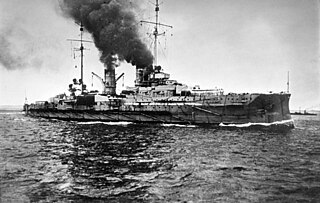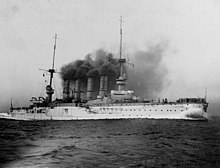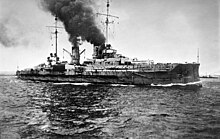
SMS Scharnhorst was an armored cruiser of the Imperial German Navy, built at the Blohm & Voss shipyard in Hamburg, Germany. She was the lead ship of her class, which included SMS Gneisenau. Scharnhorst and her sister were enlarged versions of the preceding Roon class; they were equipped with a greater number of main guns and were capable of a higher top speed. The ship was named after the Prussian military reformer General Gerhard von Scharnhorst and commissioned into service on 24 October 1907.

SMS Gneisenau was an armored cruiser of the German Kaiserliche Marine, part of the two-ship Scharnhorst class. Named for the earlier screw corvette of the same name, the ship was laid down in June 1904 at the AG Weser shipyard in Bremen, launched in June 1906, and commissioned in March 1908. She was armed with a main battery of eight 21 cm (8.3 in) guns, a significant increase in firepower over earlier German armored cruisers, and she had a top speed of 22.5 knots. Gneisenau initially served with the German fleet in I Scouting Group, though her service there was limited owing to the British development of the battlecruiser by 1909, which the less powerful armored cruisers could not effectively combat.

The Mackensen class was the last class of battlecruisers to be built by Germany in World War I. The design initially called for seven ships, but three of them were redesigned as the Ersatz Yorck class. Of the four ships of the Mackensen class, Mackensen, Graf Spee, and Prinz Eitel Friedrich were launched, and Fürst Bismarck was not—but none were completed, after wartime shipbuilding priorities were redirected towards U-boats—and the ships were broken up in the early 1920s. The lead ship of the class was named for August von Mackensen, a prominent military commander during the war. In response to the Mackensen-class ships, the British Royal Navy laid down the Admiral-class battlecruisers, all but one of which would eventually be cancelled; the sole survivor, HMS Hood, was completed after the end of the war.

SMS Blücher was the last armored cruiser built by the German Empire. She was designed to match what German intelligence incorrectly believed to be the specifications of the British Invincible-class battlecruisers. Blücher was larger than preceding armored cruisers and carried more heavy guns, but was unable to match the size and armament of the battlecruisers which replaced armored cruisers in the British Royal Navy and German Imperial Navy. The ship was named after the Prussian Field Marshal Gebhard von Blücher, the commander of Prussian forces at the Battle of Waterloo in 1815.

The Roon class was a pair of armored cruisers built for the German Kaiserliche Marine in the 1900s. The two ships of the class, Roon and Yorck, closely resembled the earlier Prinz Adalbert-class cruisers upon which they were based. The Roon class incorporated slight incremental improvements, including a pair of extra boilers. The ships were easily distinguished from their predecessors by the addition of a fourth funnel. Though the additional boilers were meant to increase the ships' speed, both vessels failed to reach their designed top speed. In addition, the ships had comparatively light armament and thin armor protection, so they compared poorly with their foreign contemporaries, particularly the armored cruisers of their primary opponent, the British Royal Navy.

SMS Roon was the lead ship of her class of armored cruisers built for the German Kaiserliche Marine in the early 1900s as part of a major naval expansion program aimed at strengthening the fleet. The ship was named after Field Marshal Albrecht von Roon. She was built at the Kaiserliche Werft in Kiel, being laid down in August 1902, launched in June 1903, and commissioned in April 1906. The ship was armed with a main battery of four 21 cm (8.3 in) guns and had a top speed of 20.4 knots. Like many of the late armored cruisers, Roon was quickly rendered obsolescent by the advent of the battlecruiser; as a result, her career was limited.

SMS Yorck was the second and final ship of the Roon class of armored cruisers built for the German Kaiserliche Marine as part of a major naval expansion program aimed at strengthening the fleet. Yorck was named for Ludwig Yorck von Wartenburg, a Prussian field marshal. She was laid down in 1903 at the Blohm & Voss shipyard in Hamburg, launched in May 1904, and commissioned in November 1905. The ship was armed with a main battery of four 21 cm (8.3 in) guns and had a top speed of 20.4 knots. Like many of the late armored cruisers, Yorck was quickly rendered obsolescent by the advent of the battlecruiser; as a result, her peacetime career was limited.

The Prinz Adalbert class was a group of two armored cruisers built for the German Kaiserliche Marine under the terms of the Second Naval Law. Two ships of the class were built, Prinz Adalbert and Friedrich Carl, between 1900 and 1904. The two ships were heavily based on the previous armored cruiser, Prinz Heinrich, with a series of incremental improvements. Their armor layout was revised slightly to improve internal protection and their main battery consisted of four 21 cm (8.3 in) guns instead of the two 24 cm (9.4 in) carried by Prinz Heinrich. The new ships also received more powerful propulsion systems, making them slightly faster. Prinz Adalbert spent her peacetime career as a gunnery training ship while Friedrich Carl initially served as the flagship of the fleet's reconnaissance forces. By 1909, she had been replaced by more modern cruisers and joined Prinz Adalbert as a training vessel.

SMS Prinz Adalbert was an armored cruiser built in the early 1900s for the Imperial German Navy. She was named after Prince Adalbert of Prussia, former Commander-in-Chief of the Prussian Navy, and was the lead ship of her class.

The Scharnhorst class was the last class of traditional armored cruisers built by the German Kaiserliche Marine. The class comprised two ships, Scharnhorst and Gneisenau. They were larger than the Roon-class cruisers that preceded them; the extra size was used primarily to increase the main armament of 21 cm (8.2 inch) guns from four to eight. The ships were the first German cruisers to reach equality with their British counterparts. The ships were named after 19th century Prussian army reformers, Gerhard von Scharnhorst and August von Gneisenau.

SMS Prinz Heinrich was a unique German armored cruiser built at the turn of the 20th century for the German Kaiserliche Marine, named after Kaiser Wilhelm II's younger brother Prince Heinrich. The second vessel of that type built in Germany, Prinz Heinrich was constructed at the Kaiserliche Werft in Kiel, being laid down in December 1898, launched in March 1900, and commissioned in March 1902. Prinz Heinrich's design was a modification of the previous armored cruiser, Fürst Bismarck, and traded a smaller main battery and thinner armor for higher speed. All subsequent German armored cruisers were incremental developments of Prinz Heinrich.

SMS Fürst Bismarck was Germany's first armored cruiser, built for the Kaiserliche Marine before the turn of the 20th century. The ship was named for the German statesman Otto von Bismarck. The design for Fürst Bismarck was an improvement over the previous Victoria Louise-class protected cruisers—Fürst Bismarck was significantly larger and better armed than her predecessors.
The Ersatz Yorck class was a group of three battlecruisers ordered but not completed for the German Kaiserliche Marine in 1916. The three ships had originally been ordered as additions to the Mackensen class, but developments abroad, particularly the British Renown-class battlecruisers, led to the navy re-designing the ships. The primary change was an increase of the main battery from eight 35-centimeter (14 in) guns to eight 38 cm (15 in) weapons. Work on the first ship had already begun by the time the navy decided to re-design the ships, so the design staff was constrained by the need to use the material already assembled.

SMS Schwaben was the fourth ship of the Wittelsbach class of pre-dreadnought battleships of the German Imperial Navy. Schwaben was built at the Imperial Dockyard in Wilhelmshaven. She was laid down in 1900, and completed in April 1904. Her sister ships were Wittelsbach, Zähringen, Wettin and Mecklenburg; they were the first capital ships built under the Navy Law of 1898, championed by Admiral Alfred von Tirpitz. Schwaben was armed with a main battery of four 24-centimeter (9.4 in) guns and had a top speed of 18 knots.

SMS Nürnberg, named after the Bavarian city of Nuremberg, was a Königsberg-class light cruiser built for the German Imperial Navy. Her sisters included Königsberg, Stettin, and Stuttgart. She was built by the Imperial Dockyard in Kiel, laid down in early 1906 and launched in August of that year. She was completed in April 1908. Nürnberg was armed with ten 4.1-inch (100 mm) guns, eight 5.2 cm (2.0 in) SK L/55 guns, and two submerged torpedo tubes. Her top speed was 23.4 knots.


















